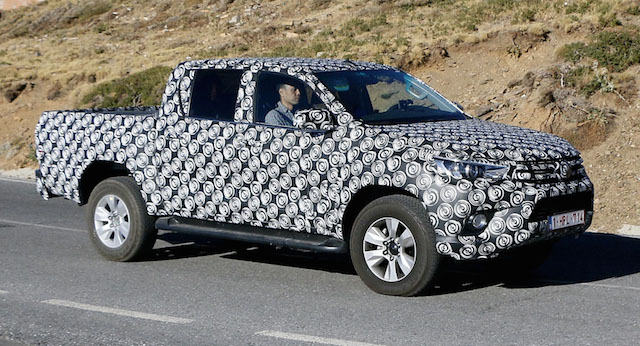
 This is the new Toyota Hilux dual cab, pictured in the south of Spain by photographers from spy agency Automedia.
This is the new Toyota Hilux dual cab, pictured in the south of Spain by photographers from spy agency Automedia.
The light truck has also been testing in Australia, where pictures of two- and four-wheel drive variants, camouflaged and dusty from Victorian bush tracks, have been published online.
In Spain, the Hilux was accompanied by a convoy of Toyotas, including a Highlander, said Automedia. In Victoria, the two Hilux models were joined by the Volkswagen Amarok, Nissan  Navara, and the Ford Ranger.
Navara, and the Ford Ranger.
No coincidence there – Hilux is being benchmarked against all three rivals, which are longer and wider and with a longer wheelbase than the current Hilux. The 4WD Amarok, Navara and Ranger also have a greater braked towing capacity: Amarok and Navara are rated at 3000kg, Ranger and its identical mechanical twin the Mazda BT-50 at 3500kg, and the Hilux at 2800kg. A bigger Hilux will likely bring improved interior packaging, ute-critical payload, and tray size.
 The images here appear to show a longer and wider body, with a longer rear overhang. We can also see a larger cabin, a bigger rear window and what appears to be a beefier rear bumper. Up front is a sportier front fascia with a slender grille flanked by distinctive headlights. The wheel arches are less pronounced.
The images here appear to show a longer and wider body, with a longer rear overhang. We can also see a larger cabin, a bigger rear window and what appears to be a beefier rear bumper. Up front is a sportier front fascia with a slender grille flanked by distinctive headlights. The wheel arches are less pronounced.
Nothing about engines yet, but expect a choice of petrol and diesel. There has also been talk of a hybrid. Toyota will no doubt want to boost the new Hilux model’s power and torque to match that of rivals.
 The 3.0-litre four-cylinder turbodiesel in the current 4WD Hilux generates 120kW/343NM. The inline five-cylinder diesel in the Ranger and BT-50 develops 147kW/470Nm; the 2.5-litre four-cylinder in the Navara puts out 126kW/403Nm and the optional 3.0-litre V6 generates 170kW/550Nm; the 2.0-litre diesel in the Amarok is good for 132kW/400NM.
The 3.0-litre four-cylinder turbodiesel in the current 4WD Hilux generates 120kW/343NM. The inline five-cylinder diesel in the Ranger and BT-50 develops 147kW/470Nm; the 2.5-litre four-cylinder in the Navara puts out 126kW/403Nm and the optional 3.0-litre V6 generates 170kW/550Nm; the 2.0-litre diesel in the Amarok is good for 132kW/400NM.
The Hilux has been the light truck of choice for around 30 years in New Zealand, but the Ranger has so far headed it on the sales charts in 2014.

